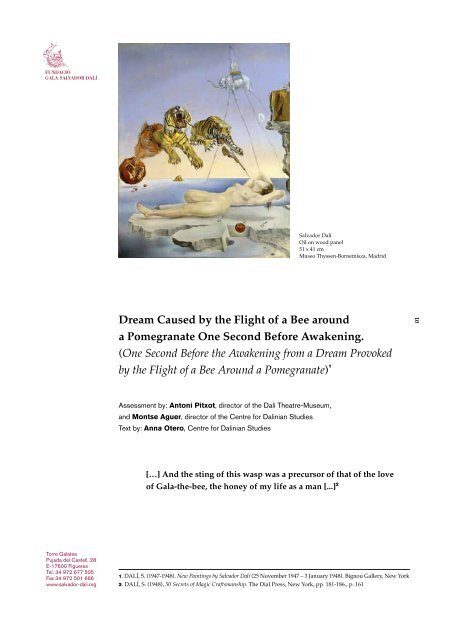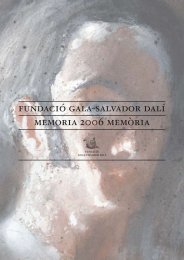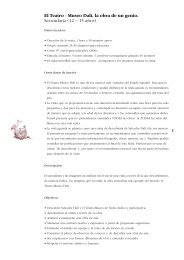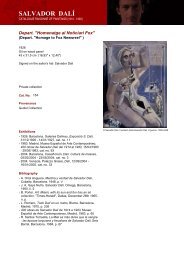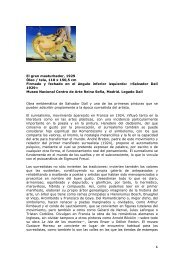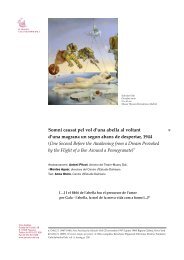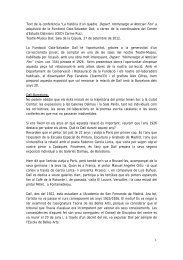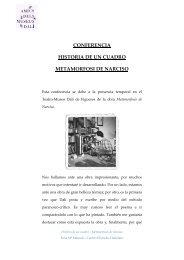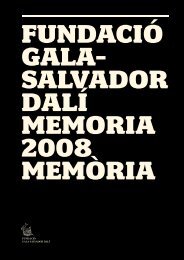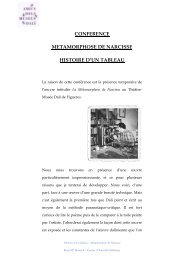Dream Caused by the Flight of a Bee around a Pomegranate One ...
Dream Caused by the Flight of a Bee around a Pomegranate One ...
Dream Caused by the Flight of a Bee around a Pomegranate One ...
- No tags were found...
You also want an ePaper? Increase the reach of your titles
YUMPU automatically turns print PDFs into web optimized ePapers that Google loves.
Salvador DalíOil on wood panel51 x 41 cmMuseo Thyssen-Bornemisza, Madrid<strong>Dream</strong> <strong>Caused</strong> <strong>by</strong> <strong>the</strong> <strong>Flight</strong> <strong>of</strong> a <strong>Bee</strong> <strong>around</strong>a <strong>Pomegranate</strong> <strong>One</strong> Second Before Awakening.(<strong>One</strong> Second Before <strong>the</strong> Awakening from a <strong>Dream</strong> Provoked01<strong>by</strong> <strong>the</strong> <strong>Flight</strong> <strong>of</strong> a <strong>Bee</strong> Around a <strong>Pomegranate</strong>) 1Assessment <strong>by</strong>: Antoni Pitxot, director <strong>of</strong> <strong>the</strong> Dalí Theatre-Museum,and Montse Aguer, director <strong>of</strong> <strong>the</strong> Centre for Dalinian StudiesText <strong>by</strong>: Anna Otero, Centre for Dalinian Studies[…] And <strong>the</strong> sting <strong>of</strong> this wasp was a precursor <strong>of</strong> that <strong>of</strong> <strong>the</strong> love<strong>of</strong> Gala-<strong>the</strong>-bee, <strong>the</strong> honey <strong>of</strong> my life as a man [...] 2Torre GalateaPujada del Castell, 28E-17600 FigueresTel. 34 972 677 505Fax 34 972 501 666www.salvador-dali.org1. DALÍ, S. (1947-1948). New Paintings <strong>by</strong> Salvador Dalí (25 November 1947 – 3 January 1948). Bignou Gallery, New York2. DALÍ, S. (1948), 50 Secrets <strong>of</strong> Magic Craftsmanship. The Dial Press, New York, pp. 181-186., p. 161
INTRODUCTIONThanks to <strong>the</strong> Fundació Gala-Salvador Dalí’s policy <strong>of</strong> active cooperation with o<strong>the</strong>r institutionswhose collections include works <strong>by</strong> Salvador Dalí, visitors to <strong>the</strong> Dalí Theatre-Museum inFigueres have recently been able to see a number <strong>of</strong> <strong>the</strong> artist’s major pictures on temporaryloan, such as Metamorphosis <strong>of</strong> Narcissus and The Persistence <strong>of</strong> Memory. In 2010 we are pleased topresent <strong>the</strong> oil painting <strong>Dream</strong> <strong>Caused</strong> <strong>by</strong> <strong>the</strong> <strong>Flight</strong> <strong>of</strong> a <strong>Bee</strong> <strong>around</strong> a <strong>Pomegranate</strong> <strong>One</strong> Second BeforeAwakening, from 1944, generously loaned <strong>by</strong> <strong>the</strong> Thyssen-Bornemisza Museum in Madrid. Thework will be on show at <strong>the</strong> Dalí Theatre-Museum in Figueres, from 9 February to 2 May 2010.For <strong>the</strong> occasion, <strong>the</strong> Fundació Gala-Salvador Dalí has prepared a dossier and a number <strong>of</strong>informative materials in order to present and analyse a significant picture from Dalí’s oeuvre.1. WORKDescriptionWhen Gala described to Dalí <strong>the</strong> strange images she had seen in a dream that was somehowrelated to <strong>the</strong> flight <strong>of</strong> a bee <strong>around</strong> a pomegranate, <strong>the</strong> artist lost no time in painting <strong>Dream</strong><strong>Caused</strong> <strong>by</strong> <strong>the</strong> <strong>Flight</strong> <strong>of</strong> a <strong>Bee</strong> <strong>around</strong> a <strong>Pomegranate</strong> <strong>One</strong> Second Before Awakening, <strong>of</strong> 1944. 3 Thesetting for <strong>the</strong> picture is once again a landscape <strong>of</strong> Portlligat, which Gala shares with twopomegranates, a large scorpionfish, two tigers, a rifle with a bayonet, a bee and an elephant withlong, insect-like legs. All <strong>of</strong> <strong>the</strong>se elements, presented in a manner that could be regarded as acinematic sequence, are part <strong>of</strong> <strong>the</strong> dream <strong>of</strong> a voluptuous reclining Gala who seems obliviousto <strong>the</strong> strange events going on <strong>around</strong> her. The reading <strong>of</strong> <strong>the</strong> painting, as its title makes clear,starts with <strong>the</strong> bee hovering over <strong>the</strong> small pomegranate in <strong>the</strong> foreground. This pomegranate02is also <strong>the</strong> origin and source <strong>of</strong> Gala’s dream, depicted on <strong>the</strong> left side <strong>of</strong> <strong>the</strong> picture.Looking a little more closely, we see that none <strong>of</strong> <strong>the</strong> objects that appear in <strong>the</strong> picture istouching any <strong>of</strong> <strong>the</strong> o<strong>the</strong>rs: everything floats, everything hangs suspended. The dream-imageis <strong>the</strong> snapshot <strong>of</strong> a precise moment, frozen and perfectly painted <strong>by</strong> hand.The Context <strong>of</strong> <strong>the</strong> WorkDalí painted <strong>Dream</strong> <strong>Caused</strong> <strong>by</strong> <strong>the</strong> <strong>Flight</strong> <strong>of</strong> a <strong>Bee</strong>… at a time <strong>of</strong> historical impasse and a stylisticcrossroads: World War II was drawing to an end and a distinctively American art was emerging.The year was 1944: Dalí’s creativity was burgeoning, coinciding with <strong>the</strong> mid point in his stayin America (1940-1948). When Dalí arrived in <strong>the</strong> United States in 1940 he declared that hisintention was to become rich and famous. During his stay in <strong>the</strong> New World, Dalí consolidatedhis persona, involved himself in various projects (sets for <strong>the</strong> <strong>the</strong>atre, ballet and opera, filmscripts, illustrations for books, designs for jewellery and clo<strong>the</strong>s, photographic projects…)and socialized with rich and influential people, ensuring his social standing.3. TAYLOR, M. (2004). “<strong>Dream</strong> <strong>Caused</strong> <strong>by</strong> <strong>the</strong> <strong>Flight</strong> <strong>of</strong> a <strong>Bee</strong> <strong>around</strong> a <strong>Pomegranate</strong>, <strong>One</strong> Second beforeAwakening” In: Dalí, Bompiani, Milan, p. 334
Painting for <strong>the</strong> ballet Sentimental ColloquyPoster advertising <strong>the</strong> book Hidden FacesThe year 1944 was a very productive one for Dalí. He designed advertising images for <strong>the</strong>stocking manufacturer Bryans, for perfume, lipstick and o<strong>the</strong>r products for Elsa Schiaparelli,and for McCurrach ties; he contributed articles and illustrations to a number <strong>of</strong> magazines, andin June published his only novel, Hidden Faces. At <strong>the</strong> end <strong>of</strong> <strong>the</strong> summer he signed <strong>the</strong> contractthat resulted in his creating <strong>the</strong> dream sequence for Alfred Hitchcock’s film Spellbound, whichpremiered in 1945. During <strong>the</strong> last three months <strong>of</strong> 1944 he designed <strong>the</strong> sets for <strong>the</strong> stage playSentimental Colloquy and created <strong>the</strong> libretto, <strong>the</strong> costumes and <strong>the</strong> sets for <strong>the</strong> ballet Mad Tristan.2. SALVADOR DALÍThe Historical Context in Europe and <strong>the</strong> United States03With <strong>the</strong> outbreak <strong>of</strong> World War II, <strong>the</strong> art scene in both Europe and America underwent asudden drastic change, and among <strong>the</strong> artists who fled a Europe at war many sought refuge in<strong>the</strong> United States. This migration left Europe relatively bereft <strong>of</strong> artists while America gainedsignificantly in artistic importance. The new continent’s absorption <strong>of</strong> transatlantic émigréintellectuals coincided with <strong>the</strong> advent <strong>of</strong> a specifically American form <strong>of</strong> modern art: AbstractExpressionism. Dalí painted <strong>Dream</strong> <strong>Caused</strong> <strong>by</strong> <strong>the</strong> <strong>Flight</strong> <strong>of</strong> a <strong>Bee</strong>… at a time when <strong>the</strong> Surrealism<strong>of</strong> <strong>the</strong> exiled coexisted with <strong>the</strong> newly emerging Abstract Expressionism. This was a period <strong>of</strong>great upheaval in art, a moment <strong>of</strong> syn<strong>the</strong>sis between abstraction and surrealism, marked <strong>by</strong><strong>the</strong> emergence <strong>of</strong> what would come to be known as <strong>the</strong> New York School, whose prominentfigures included Mark Rothko, Jackson Pollock, William Baziotes and Robert Mo<strong>the</strong>rwell. Dalítook no part in this pictorial transition at <strong>the</strong> artistic level, in <strong>the</strong> sense that he was not a member<strong>of</strong> any movement and instead remained faithful to his own style. There was to be no stylisticbreak in his work, no move towards Abstract Expressionism; nor did he form strong personalties with any <strong>of</strong> <strong>the</strong> émigré artists. Maintaining his provocative, rebellious spirit, Dalí baptisedhis painting anew, calling for a return to classicism and turning to photographic realism. Aswe can see in <strong>Dream</strong> <strong>Caused</strong> <strong>by</strong> <strong>the</strong> <strong>Flight</strong> <strong>of</strong> a <strong>Bee</strong>… this was bound up with an evident pictorialpreciosity, and indeed Dalí described painting as ‘“photography” done <strong>by</strong> hand and in colours<strong>of</strong> <strong>the</strong> “concrete irrationality” and <strong>of</strong> <strong>the</strong> imaginative world in general’. 44. DALÍ, S. (1934), ‘The Latest Modes <strong>of</strong> Intellectual Stimulation for <strong>the</strong> Summer <strong>of</strong> 1934’. In: Finkelstein, H.The Collected Writings <strong>of</strong> Salvador Dalí, Cambridge University Press, 1998, p. 254
In <strong>the</strong> midst <strong>of</strong> this turmoil <strong>of</strong> tendencies and changes, Dalí engaged in a dialogue with ‘<strong>the</strong>American way <strong>of</strong> life’, making use <strong>of</strong> <strong>the</strong> techniques <strong>of</strong> promotion and advertising that hadended up defining so much <strong>of</strong> American culture. Dalí took advantage <strong>of</strong> his stay in Americato put <strong>the</strong> finishing touches to <strong>the</strong> persona <strong>of</strong> Salvador Dalí that was to gain him universalrecognition.Artistic InfluencesAt an opening in <strong>the</strong> Julien Levy Gallery in New York in April 1941, three years before hepainted <strong>Dream</strong> <strong>Caused</strong> <strong>by</strong> <strong>the</strong> <strong>Flight</strong> <strong>of</strong> a <strong>Bee</strong>…, Dalí announced that his painting was to bringabout a return to ‘<strong>the</strong> classical era’. Only a few months after his arrival in <strong>the</strong> United States,Dalí was looking for inspiration and a new pictorial model in <strong>the</strong> proportion and harmony <strong>of</strong><strong>the</strong> Italian Renaissance, marking not so much a radical stylistic break as a departure from <strong>the</strong>Surrealist fold:‘My surrealist glory was worthless. I must incorporate surrealism in tradition. Myimagination must become classic again. I had before me a work to accomplish forwhich <strong>the</strong> rest <strong>of</strong> my life would not suffice. Gala made me believe in this mission.’ 5Visually, we find not a break in <strong>the</strong> style <strong>of</strong> his work but a reutilizing and exploiting <strong>of</strong> certainelements, <strong>of</strong> which <strong>the</strong> landscape is <strong>the</strong> most striking example. Associations with <strong>the</strong> world<strong>of</strong> mass culture are manifestly present in Dalí’s paintings <strong>of</strong> <strong>the</strong> nineteen forties. In everydaythings, used and demanded <strong>by</strong> <strong>the</strong> public at large, he found a rich source <strong>of</strong> inspiration. Hehad previously depicted a Coca-Cola bottle in <strong>the</strong> 1943 painting The Poetry <strong>of</strong> America, severalyears in advance <strong>of</strong> <strong>the</strong> iconography <strong>of</strong> Pop Art, and <strong>the</strong> tigers in <strong>Dream</strong> <strong>Caused</strong> <strong>by</strong> <strong>the</strong> <strong>Flight</strong> <strong>of</strong> a<strong>Bee</strong>… were taken from <strong>the</strong> posters advertising <strong>the</strong> popular Ringling Bros. and Barnum & BaileyCircus. These borrowings exemplify <strong>the</strong> working method <strong>of</strong> a great artist-observer, filteringand absorbing <strong>the</strong> world <strong>around</strong> him and painting his pictures as if <strong>the</strong>y were hand-colouredphotographs, effectively assimilating painting to <strong>the</strong> photographic image.04Ringling Barnun Bailey Circus posterDalí took advantage <strong>of</strong> this mediatic moment to seize <strong>the</strong> attention <strong>of</strong> <strong>the</strong> media whileworking with and exploring <strong>the</strong> potential <strong>of</strong> supports o<strong>the</strong>r than <strong>the</strong> traditional canvas. Themultitude <strong>of</strong> options Dalí tested out — new supports, <strong>the</strong> artistic function <strong>of</strong> popular imagery,<strong>the</strong> championing <strong>of</strong> an anachronistic classicism… — looked forward to many aspects <strong>of</strong>contemporary art: certain Dalinian connotations can be seen in <strong>the</strong> work <strong>of</strong> artists such as AndyWarhol, Roy Lichtenstein and Jeff Koons.5. DALÍ, S. (1942). The Secret Life <strong>of</strong> Salvador Dalí. The Dial Press, New Press, p. 350
3. INTERPRETATIONThe LandscapeThe landscape in <strong>Dream</strong> <strong>Caused</strong> <strong>by</strong> <strong>the</strong> <strong>Flight</strong> <strong>of</strong> a <strong>Bee</strong>… is perhaps <strong>the</strong> most recognizable elementin <strong>the</strong> picture, in that it corresponds to Dalí’s immediate and omnipresent surroundings. Forall <strong>the</strong>ir realism, <strong>the</strong> landscapes that Dalí painted in <strong>the</strong> nineteen forties are products <strong>of</strong> <strong>the</strong>imagination, <strong>of</strong> dreams and memories: <strong>the</strong> artist lived in <strong>the</strong> United States continuously for aperiod <strong>of</strong> eight years (1940-1948), a long way from <strong>the</strong> Empordà.The figure <strong>of</strong> Gala lies stretched out on a rocky platform that floats above <strong>the</strong> sea. The cliff on<strong>the</strong> right is reminiscent <strong>of</strong> those Dalí painted during <strong>the</strong> thirties and, indeed, continued to paint.A few olive branches adorning <strong>the</strong> summit <strong>of</strong> <strong>the</strong> cliff are <strong>the</strong> only vegetation on <strong>the</strong> painting.The blue <strong>of</strong> <strong>the</strong> sea and <strong>the</strong> sky is divided <strong>by</strong> <strong>the</strong> first light <strong>of</strong> day, coinciding with <strong>the</strong> moment<strong>of</strong> ‘one second before awakening’; <strong>the</strong> time is dawn and <strong>the</strong> moon still lingers in <strong>the</strong> sky.In many <strong>of</strong> <strong>the</strong> pictures from Dalí’s American period (1940-1948) <strong>the</strong> landscape takes ona predominant presence. The close personal relationship that Dalí establishes with <strong>the</strong>Mediterranean setting can be seen as an extension <strong>of</strong> himself; <strong>the</strong> landscape <strong>of</strong> Cadaqués /Portlligat / Cap de Creus and Dalí are inseparable. In his writings, Dalí acknowledged <strong>the</strong>primacy <strong>of</strong> <strong>the</strong> landscape in his art:‘[…] I need only to close my eyes in order to recapture landscapes and scenes intact,but at <strong>the</strong> time I established <strong>the</strong> strangest kind <strong>of</strong> dialogue with myself. Everyrock, every promontory <strong>of</strong> Cape Creus is in permanent metamorphosis. Each is asuggestion that prompts spontaneous visualization <strong>of</strong> an eagle, a camel, a rooster, alion, a woman – but if you approach from <strong>the</strong> sea, <strong>the</strong> nearer you get, <strong>the</strong> more <strong>the</strong>symbolism develops and changes. It is a continual simulacrum. The bird becomesa wild animal and <strong>the</strong>n a barnyard fowl. Like living in a constant mirage… and yet,when we land, <strong>the</strong> granite beneath our feet is hard, compact, clear, implacable – afterhaving double-dealt us so constantly.’ 605The <strong>Pomegranate</strong>Gala’s dream, which is ‘caused <strong>by</strong> <strong>the</strong> flight <strong>of</strong> a bee <strong>around</strong> a pomegranate’, commences with<strong>the</strong> broken-open pomegranate, two seeds <strong>of</strong> which are falling into <strong>the</strong> sea and will become <strong>the</strong>pomegranate trees that Gala will plant next to <strong>the</strong> house at Portlligat. The pomegranate is an<strong>Pomegranate</strong> <strong>of</strong> PortlligatJewel The <strong>Pomegranate</strong> Heart made <strong>of</strong> gold, rubies and diamonds6. DALÍ, S. (1976). The Unspeakable Confessions <strong>of</strong> Salvador Dalí. William Morrow and Company, Inc., new York, p. 129
autumn fruit with a very ancient tradition in <strong>the</strong> Mediterranean: in <strong>the</strong> Christian religion itsymbolizes love, resurrection, eternal life and fertility, and it figures prominently in Greek ando<strong>the</strong>r mythologies. It is a fruit <strong>of</strong> evil sweetness with a variety <strong>of</strong> meanings and associations,and is both <strong>the</strong> origin and <strong>the</strong> cause <strong>of</strong> what is happening in <strong>the</strong> picture.A scorpionfish has emerged from <strong>the</strong> heart-shaped opening in <strong>the</strong> skin <strong>of</strong> fruit. In 1949, whenDalí turned to designing jewellery, he took <strong>the</strong> heart-like form <strong>of</strong> an opened pomegranate as <strong>the</strong>basis for a ‘pomegranate heart’ <strong>of</strong> gold, rubies and diamonds.The ScorpionfishThe fish being expelled from <strong>the</strong> pomegranate is a scorpionfish, <strong>of</strong> a species found in <strong>the</strong>Mediterranean. The scorpionfish habitually remains motionless among <strong>the</strong> rocks during <strong>the</strong>day, and feeds at night. The mimicry <strong>of</strong> its colouration makes it difficult to spot, but despitethis invisibility <strong>the</strong> large-eyed scorpionfish takes in everything that goes on <strong>around</strong> it. Thescorpionfish raises it poisonous dorsal fin when it senses danger, as we see it doing here, andhas a very large mouth with which to swallow its prey. The scorpionfish is a predator whoseapparent stillness deceives its victims, preventing <strong>the</strong>m from reacting in time to its attack. Wesee Dalí’s aggressive scorpionfish in <strong>the</strong> act <strong>of</strong> swallowing a tiger, which in turn is expelling asecond tiger from its mouth, as if it were an echo <strong>of</strong> itself.The TigersIn <strong>the</strong> central part <strong>of</strong> <strong>the</strong> dream, two snarling tigers spring at Gala. These animals remain verysimilar to <strong>the</strong> tigers on <strong>the</strong> posters <strong>of</strong> <strong>the</strong> Ringling Bros. and Barnum & Bailey Circus, <strong>the</strong> biggestAmerica. If we bear in mind that <strong>the</strong> merged circus already had been performing up and down<strong>the</strong> country for many years when Dalí arrives in <strong>the</strong> United States in 1940, it is more than likelythat he would have seen this image on posters announcing forthcoming shows. In this respectDalí draws on <strong>the</strong> popular imagery <strong>of</strong> <strong>the</strong> circus to awaken Gala from her sleep. However, it isnot <strong>the</strong> roar <strong>of</strong> <strong>the</strong> tiger but <strong>the</strong> rifle with its bayonet, a simulacrum <strong>of</strong> <strong>the</strong> bee’s sting, that willrouse her from her slumber.06The ElephantThe <strong>the</strong>me <strong>of</strong> <strong>the</strong> dream is also apparent in <strong>the</strong> figure <strong>of</strong> <strong>the</strong> elephant with greatly elongatedlegs, an animal that Dalí incorporated into his iconography in <strong>the</strong> early forties. The aes<strong>the</strong>ticinspiration for <strong>the</strong> elephant-cum-insect with an obelisk on its back was <strong>the</strong> Pulcino della Minerva,a sculpture <strong>of</strong> an elephant designed <strong>by</strong> Bernini in <strong>the</strong> seventeenth century, which standsoutside <strong>the</strong> basilica <strong>of</strong> Santa Maria sopra Minerva in Rome. Bernini’s Pulcino della Minerva isa recreation <strong>of</strong> an elephant bearing a 6 th -century BCE Egyptian obelisk on its back. Curiously,<strong>the</strong> Bernini sculpture has similarities with <strong>the</strong> woodcut <strong>of</strong> an elephant in <strong>the</strong> Renaissance novelHypnerotomachia Poliphili (1499). <strong>Dream</strong>s play a very important part in <strong>the</strong> novel, and <strong>the</strong> image<strong>of</strong> <strong>the</strong> elephant bearing <strong>the</strong> obelisk we see in Dalí’s painting effectively bestrides <strong>the</strong> dream.Dalí thus takes <strong>the</strong> Bernini elephant, which derives in its turn from a Renaissance dream, andDalífies it, stretching its legs. In a sense, with this elephant Dalí is inviting us to share in one <strong>of</strong><strong>the</strong> many metamorphoses that occur in his works.
‘[…] flying about like a bee, which is also one <strong>of</strong> <strong>the</strong> names which I have given her,for like a bee she brings me all <strong>the</strong> oils, all <strong>the</strong> media, and it is thus that I find <strong>the</strong>pentagonal hive <strong>of</strong> my studio filled with all <strong>the</strong> pollens which <strong>the</strong> painter, at everymoment <strong>of</strong> <strong>the</strong> day, needs to be able to spin <strong>the</strong> integral honey <strong>of</strong> his work.’ 7<strong>Dream</strong>sThe precise moment painted <strong>by</strong> Dalí in <strong>Dream</strong> <strong>Caused</strong> <strong>by</strong> <strong>the</strong> <strong>Flight</strong> <strong>of</strong> a <strong>Bee</strong>… is exactly onesecond before Gala awakes to find herself attacked <strong>by</strong> a dream in <strong>the</strong> form <strong>of</strong> a rifle witha bayonet and two tigers, one being swallowed <strong>by</strong> a scorpionfish which in turn has beenexpelled from an open pomegranate. With this succession <strong>of</strong> dreamlike actions Dalí lets us seethat Surrealism and Freudian psychoanalysis are still present in <strong>the</strong> iconography <strong>of</strong> his work:<strong>the</strong> free association <strong>of</strong> images leads <strong>the</strong> unconscious to <strong>the</strong> conscious mind. In looking at <strong>the</strong>painting we involuntarily become interpreters <strong>of</strong> dreams. With <strong>Dream</strong> <strong>Caused</strong> <strong>by</strong> <strong>the</strong> <strong>Flight</strong> <strong>of</strong> a<strong>Bee</strong>… Dalí wants to share with <strong>the</strong> spectator-interpreter a moment from Gala’s subconscious asthis has been interpreted <strong>by</strong> him with his brushes.08<strong>Dream</strong> <strong>Caused</strong> <strong>by</strong> <strong>the</strong> <strong>Flight</strong> <strong>of</strong> a <strong>Bee</strong>…,Dalí had always been fascinated <strong>by</strong> dreams, as <strong>the</strong> following entry in his adolescent diary attests:‘It is cloudy today like yesterday. But I feel fine and I get up. I had a delightfulnight. <strong>Dream</strong>s are something I love. I usually pass <strong>the</strong> nights in extraordinaryand delightful dreams, which I do not recount because all <strong>the</strong> details fly from mymemory.’ 8Long after <strong>the</strong> most Surrealist years (<strong>the</strong> 1930s), dreams continue to be a recurrent <strong>the</strong>me inthroughout Dalí’s career. Also in 1944, <strong>the</strong> year he painted <strong>Dream</strong> <strong>Caused</strong> <strong>by</strong> <strong>the</strong> <strong>Flight</strong> <strong>of</strong> a <strong>Bee</strong>…,he was invited to design <strong>the</strong> dream scene for Alfred Hitchcock’s film Spellbound. Dalí told <strong>the</strong>press at <strong>the</strong> time that he mostly dreamt in shades <strong>of</strong> grey, but that a few times each month,7. DALÍ, S. (1948), 50 Secrets <strong>of</strong> Magic Craftsmanship. The Dial Press, New York, pp. 181-1868. DALÍ, S. (2003), ‘Un Diari 1919-1920: les meves impressions i records íntims’. In: Obra completa, Barcelona;[Figueres]: Ediciones Destino; Fundació Gala-Salvador Dalí, vol. 1, Escrits autobiogràfics, p. 196
although this was not a good sign, he dreamt in colour. And it was as a specialist in dreams thatLife magazine commissioned Dalí to write a piece about a nightmare. In ‘Nightmare Journey’ hetold <strong>the</strong> story <strong>of</strong> <strong>the</strong> train journey he made from New York to San Francisco, during which hewas assailed <strong>by</strong> fears and anxieties about confronting <strong>the</strong> practical aspects <strong>of</strong> everyday life. Dalístarts his account with a confession:‘At night I always dream <strong>of</strong> extremely agreeable things, and it is precisely when Iam perfectly wide-awake, in broad daylight and in contact with practical life, thatmy most hallucinatory nightmares have always occurred.’ 9099. DALÍ, S. ‘Nightmare Journey’, Life, 6 March 1944.
APPENDICEWorks Produced <strong>by</strong> Dalí in 1944February:Advertisement, ‘John Frederics Golden Arrow Toiletries’, in Vogue, 01/02/1944.Article, ‘<strong>Dream</strong> vs. Reality’, in Vogue, with drawings <strong>by</strong> Dalí advertising dresses <strong>by</strong> HenriBendel, Garfinckel’s and L. S. Ayres, 15/02/1944.March:Advertisement, ‘The 4 Oils <strong>of</strong> Schiaparelli Shocking Radiance’, in Harper’s Bazaar, 03/1944.Advertisement, ‘John Frederics Golden Arrow Toiletries’, in Harper’s Bazaar, 03/1944.Article, ‘Nightmare Journey’, <strong>by</strong> Salvador Dalí in Life, 06/03/1944.Article, ‘Uncovering Hidden Faces’, written and illustrated <strong>by</strong> Salvador Dalí in <strong>the</strong> magazineTown & Country, 03/1944.April:Design for <strong>the</strong> cover <strong>of</strong> Vogue, 01/04/1944.Advertisement, ‘John Frederics Golden Arrow Toiletries’ in Vogue, 01/04/1944.May:Advertisement, ‘Schiaparelli Red Shocking Radiance’ in Vogue, 15/05/1944.Advertisement, ‘Bryans Hosiery’ in Vogue, 15/05/1944.June:Publication <strong>of</strong> Hidden Faces, Salvador Dalí’s first and only novel, with a his own cover design.10July:Advertisement, ‘The 4 Oils <strong>of</strong> Schiaparelli Shocking Radiance’, in Harper’s Bazaar, 07/1944.August:Signing <strong>of</strong> <strong>the</strong> contract to create <strong>the</strong> dream scene in Alfred Hitchcock’s film Spellbound.September:Advertisement, Bryans Hosiery, in Vogue, 01/09/1944.Advertisement, ‘Give Ties With Personality’ <strong>of</strong> ties designed <strong>by</strong> Salvador Dalí, <strong>the</strong> TimesMagazine, 17/09/1944.Advertisement, ‘The 4 Oils <strong>of</strong> Schiaparelli Shocking Radiance’, in <strong>the</strong> magazine Art News,09/1944.October:Advertisement, ‘Men’s Ties <strong>by</strong> Salvador Dalí’, for ties designed <strong>by</strong> Salvador Dalí, in <strong>the</strong> dailyUnion Morning, 03/10/1944.Advertisement, Bryans Hosiery, in Vogue, 15/10/1944.Set designs for <strong>the</strong> ballet Sentimental Colloquy, premiered at <strong>the</strong> International Theater in NewYork, 30/10/1944.Advertisement, McCurrach Ties, for ties designed <strong>by</strong> Salvador Dalí in Esquire: The Magazine forMen, 10/1944.
November:Paints The Seven Lively Arts to a commission from Billy Rose for <strong>the</strong> Ziegfield Theater in NewYork.Advertisement, ‘A Red Heart Decorated <strong>by</strong> Dalí’, in Harper’s Bazaar, 11/1944.Designs a poster on syphilis, which is presented in an exhibition organized <strong>by</strong> Elsa Schiaparelliin <strong>the</strong> Wildestein Galleries in New York, 06/11/1944.Advertisement for Vogue in Women’s Wear, 16/11/1944.December:Set, costume and programme designs for <strong>the</strong> ballet Mad Tristan, which is premiered <strong>by</strong> <strong>the</strong> BalletInternational at <strong>the</strong> International Theater in New York, 15/12/1944.Article, ‘Crazy… Like a Fox’, <strong>by</strong> Mel Heimer, published in New York Journal American andillustrated with Salvador Dalí’s drawing ‘Hollywood’, 02.12.1944.Advertisement, Bryans Hosiery, in <strong>the</strong> magazine Art News Annual, 12/1944.Advertisement, ‘Salvador Dalí Designs Ties’, for ties designed <strong>by</strong> Salvador Dalí, in <strong>the</strong> daily TheNew York Sun, 06/12/1944.11
NOTES ON THE PRELIMINARY SKETCHES OF THE WORKIrene Civil, Conservation and Restoration Dept.<strong>of</strong> <strong>the</strong> Fundació Gala-Salvador DalíThe Dalí Foundation keeps a large number <strong>of</strong> drawings made in preparation for Dalí works,and <strong>the</strong>y constitute an important source <strong>of</strong> information about <strong>the</strong> artist’s creative process andworking method, as well as <strong>the</strong> techniques and materials he used. In <strong>the</strong> case <strong>of</strong> <strong>Dream</strong> <strong>Caused</strong> <strong>by</strong><strong>the</strong> <strong>Flight</strong> <strong>of</strong> a <strong>Bee</strong>... <strong>the</strong> Foundation has in its collections a pencil and charcoal sketch on tracingpaper <strong>of</strong> <strong>the</strong> work’s central composition, in which Dalí emphasises <strong>the</strong> crossed diagonals thatform <strong>the</strong> figures (Fig. 1). Then again, <strong>the</strong> artist makes some tenuous schematic outlines in pencil<strong>of</strong> <strong>the</strong> rocks on <strong>the</strong> right-hand side <strong>of</strong> <strong>the</strong> painting and <strong>of</strong> <strong>the</strong> figure <strong>of</strong> Gala, using a page <strong>of</strong>a book about geometry dating from 1938, Essai sur le rythme (Fig. 2). And on a sheet from adrawing pad we find <strong>the</strong> outline <strong>of</strong> Gala’s outstretched silhouette, sketched rapidly and easilyin pencil (Fig. 3). And finally <strong>the</strong>re is a more complete preliminary study <strong>of</strong> <strong>the</strong> dreaming Galafigure, a pencil drawing on Fabriano paper, which is presented at <strong>the</strong> exhibition along with <strong>the</strong>final painting itself (Fig. 4). This preparatory drawing <strong>of</strong> <strong>the</strong> main image was in all likelihood<strong>the</strong> one used as <strong>the</strong> basis <strong>the</strong> artist transferred to <strong>the</strong> wood panel.In addition to his preparatory drawings, Dalí took up again motifs from previous paintingsor designs taken from magazines and o<strong>the</strong>r media from mass culture, such as <strong>the</strong> tiger from acircus advertising poster or <strong>the</strong> elephant in a photograph illustrating a book about <strong>the</strong> animalkingdom, which Dalí traced in ink (Fig. 6). Then, when he had <strong>the</strong> image defined — whe<strong>the</strong>rfrom his preparatory drawing or from a poster photo — he had to transfer it to <strong>the</strong> final surface<strong>of</strong> <strong>the</strong> panel. Dalí explained his transfer method in his treatise on painting entitled 50 Secrets <strong>of</strong>Magic Craftsmanship; <strong>the</strong> method basically consisted in utilisation <strong>of</strong> a transparent intermediateplastic sheet for tracing out and conveying <strong>the</strong> image to <strong>the</strong> panel. Two <strong>of</strong> <strong>the</strong>se plastic sheetsare conserved at <strong>the</strong> Dalí Foundation: one with <strong>the</strong> image <strong>of</strong> <strong>the</strong> work’s central image <strong>of</strong> <strong>the</strong>tiger (Fig. 5) and <strong>the</strong> o<strong>the</strong>r with <strong>the</strong> image <strong>of</strong> <strong>the</strong> elephant (Fig. 7).12


